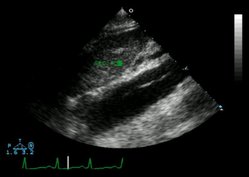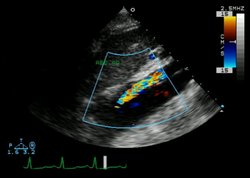LA JOLLA, CALIF. -- Four pregnancy-related deaths due to aortic dissection and a fifth report describing a woman who survived a dissection 2 weeks after a cesarean section have raised questions about whether Turner's syndrome patients are good candidates for childbearing, even though in vitro fertilization has led many to pursue pregnancy using donor oocytes.
The maternal mortality rate, based on 194 known in vitro fertilization (IVF) pregnancies in Turner's syndrome patients, is estimated to be 2%, Dr. Richard H. Reindollar reported during the annual meeting of the North American Society for Pediatric and Adolescent Gynecology.
However, the maternal mortality rate could be even higher than 2%. "This is something we should think long and hard about" as more of these patients pursue pregnancy, said Dr. Reindollar, who is the director of reproductive endocrinology and infertility at Beth Israel Deaconess Medical Center in Boston.
Just because donor oocyte IVF can be used to help these patients become pregnant doesn't mean that it should be used. He stressed that increased cardiac demands of pregnancy may be especially perilous for Turner's syndrome patients, who may be at risk for aortic dilation, dissection, and rupture, even in the absence of risk factors.
He and his associates conducted a survey of 259 donor oocyte programs and found that fewer than half of Turner syndrome patients were screened with echocardiography as part of their work-up (Fertil. Steril. 80[3]:498-501, 2003). Among the 72 screened patients, 6 (8%) had abnormal results.
A subsequent literature review by Dr. Reindollar's team at the medical center and Harvard Medical School in Boston turned up four deaths. They included:
* Two deaths reported in 1997, both of which involved aortic dissection in the third trimester. One patient had a history of hypertension and a slightly dilated aorta.
* One death after surgical intervention in a woman whose aortic dissection was diagnosed late in a pregnancy complicated by preeclampsia.
* One death associated with aortic dissection at 36 weeks' gestation in a patient with a history of juxtaductal coarctation repaired during childhood.
In addition, Dr. Reindollar identified a case in which a Turner's syndrome patient who did not have any risk factors suffered an aortic dissection 2 weeks after a cesarean section for eclampsia. That patient survived.
Dr. Reindollar said spontaneous pregnancy is very rare in Turner's syndrome patients, who are born with complete or partial absence of the second sex chromosome.
Only about 5% of patients have menstrual periods, and roughly 1% becomes pregnant naturally. These pregnancies are associated with a very high loss rate as well as a high rate of congenital anomalies.
A 1998 review of 160 spontaneous pregnancies found that only 38% resulted in the birth of healthy children with normal karyotypes (Gynecol. Endocrinol. 12[2]:83-87, 1998).
The advent of IVF, however, provided new reproductive possibilities to Turner's syndrome patients, since the vast majority have normal uteri and are physically capable of becoming pregnant by using donor oocytes. The first such pregnancy was reported in 1988, and the largest series reported to date found a 19% "take-home baby" rate per cycle (Hum. Reprod. 12[2]:279-85, 1997).
Results of Dr. Reindollar's survey demonstrated, however, that many fertility specialists had "no clue" about the cardiac risks facing Turner's syndrome patients. That may be because most of the 14 major articles on the subject have appeared in journals read by geneticists, cardiologists, and pediatricians but rarely studied by obstetricians, gynecologists, or endocrinologists, he said.
These studies detail numerous cases of aortic aneurysm, dissection, or rupture in nonpregnant patients and note that some share histopathologic features, such as cystic medial necrosis, with Marfan syndrome patients (Pediatrics 102[1]:e12, 1998). Pregnancy is contraindicated in Marfan syndrome patients with aortic dilation, he noted.
Dr. Reindollar said nonpregnant Turner's syndrome patients should undergo annual cardiac, blood pressure, and x-ray examinations and should have echocardiography screening every 3-5 years. If the descending aorta cannot be inspected, patients should have an MRI. He also recommended that patients wear a medical identification bracelet noting their risk of dissection even in the absence of risk factors.
Patients considering pregnancy should be extensively counseled about the risks, benefits, contraindications, and warning symptoms of catastrophic cardiac complications. In those patients who decide to pursue pregnancy despite the risks, Dr. Reindollar suggested a baseline cardiac evaluation, including a consultation with a cardiologist, and an echocardiography each trimester.
BY BETSY BATES
Los Angeles Bureau
COPYRIGHT 2004 International Medical News Group
COPYRIGHT 2004 Gale Group




